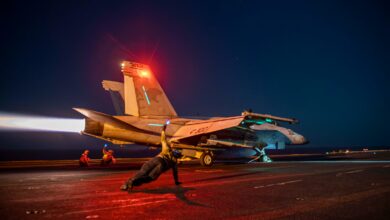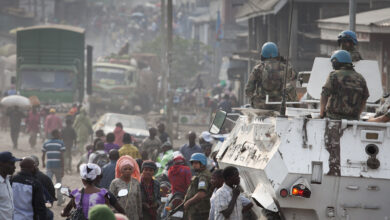On April 18, Islamic State claimed its first attack in the Democratic Republic of Congo. Not only did it strike in a new location, but ISIS attributed the attack to an entirely new province, Wilayat Central Africa. Before this claim and even before the fall of the jihadist group’s ‘caliphate’ in Iraq and Syria, there was evidence of growing ties between ISIS and the DRC-based militant group Allied Democratic Forces. Just how lasting this new province will be remains to be seen.
In video released by al-Furqan media on April 29, ISIS leader Abu Bakr al-Baghdadi, in his first appearance for five years, is seen handling documents about some global affiliates, including one entitled “Wilayat Central Africa.”

The April 18 claim issued through the Amaq propaganda agency said that ISIS fighters had killed and wounded several Congolese soldiers in an attack on the town of Kamango, near the border with Uganda. This was followed by a statement from Nashir News Agency and another from Amaq saying “Soldiers of the Caliphate” had attacked an army base in Bovata, around 5 km from Kamango, killing three Congolese soldiers and wounding five.
The Nashir claim attributed this attack to “Wilayat Central Africa,” the first such claim for this province. However, a Central African province was previously mentioned by Baghdadi in an August 2018 speech, meaning ISCAP had existed for almost a year before ISIS first publicly attributed an attack to the wilayat.
Reuters reported the attack killed two soldiers and a civilian, and that it had been carried out by the ADF, a Ugandan-led but DRC-based militant group mainly operating in the eastern North Kivu province.
The ADF was founded in 1995 with a stated goal of overthrowing the Ugandan government, but has since drifted to carrying out attacks and massacres in DRC against military and civilian targets. The ADF did have Islamist roots, with many of its leaders and early members coming from Uganda’s Salifist movments, but the extent to which religion is important to them has been unclear.

Issue 179 of ISIS’s weekly Al-Naba newsletter released on April 25 claimed a second attack by ISCAP, saying fighters killed three soldiers and wounded another in the Butembo area four days earlier.
Al-Naba also published the first known image of ISCAP. Around 15 militants are present in the picture, standing in a circle with their hands together in the center. This pose appears similar to one often made by militants when pledging allegiance to Baghdadi, for example the recently published pledge by Sri Lankan suicide bombers and one from Saudi Arabia, so the picture could be a still from a bayah video.
The militants are armed with a variety of weapons identified for The Defense Post by Calibre Obscura, including FN MAG and Type 80 general purpose machine guns, and Type 3 AK-47 and AKM assault rifles. A PG-7V warhead which appears to have a hole in it can also be seen. Tents and buildings in the background suggest the picture could have been taken at the edge of the militant’s camp.
That the ADF would have carried out the attack is not surprising – much of ISIS’s expansion around the world has come from working with local militant groups, which establish ties with ISIS and pledge allegiance to Baghdadi. If the bayat is accepted, they become an ISIS affiliate, and some later become official provinces. Examples include Boko Haram becoming Islamic State West Africa Province, various militant groups in the Philippines and Indonesia evolving into Islamic State East Asia Province, and Ansar Beit al-Maqdis becoming Islamic State Sinai Province.
Not every ISIS affiliate becomes an official province. Tunisia has been an active ISIS affiliate for years but has only ever remained an affiliate, never being designated a full wilyat. This could suggest ISIS sees greater potential in ISCAP.
There is evidence ISIS has repeated this model with the ADF. Several signs point to the building of tentative ties between them before the creation of ISCAP.
A book published by the Islamic State’s Office of Research and Studies, which produces texts espousing the group’s ideology, was found on the body of a dead ADF militant in February 2018.
A report by the Congo Research Group published in November 2018 suggests the ADF has undergone a radicalization with a “shift in the rhetoric employed by the movement, from a war against the Ugandan government to a broader struggle for Islam.”
Part of this shift included adopting the name Madina at Tauheed Wau Mujahedeen (the City of Monotheism and Holy Warriors) as well as a flag incorporating elements used by many jihadist groups including ISIS. The Congo Research Group argued the ADF was “making a tentative attempt to align itself with other militant Islamist groups.” This attempt appears to have succeeded with the inclusion of “Central Africa Province” in the Baghdadi video.
Most significantly, the U.S. imposed sanctions on two Kenya-based ISIS financiers who it says were responsible for sending funds to ADF fighters in DRC. Waleed Ahmed Zein and Halima Adan Ali allegedly set up an extensive financial network spanning Europe, Africa, the Middle East, and the Americas, and between 2017 and early 2018 they moved $150,000 to ISIS fighters in Libya, Syria, and Central Africa. Some of this funding was reportedly supplied to the ADF, with the Congo Research Group saying that Zein moved money from the United Kingdom, South Africa and Syria to the DRC-based group.
Various governments have also warned about the possible expansion of ISIS into DRC. Last May, the Director-General of Uganda’s Internal Security Organization Colonel Kaka Bagyenda said ISIS had collaborated with the ADF. However, Uganda has in the past attempted to define the narrative around the ADF to suit its own ends.
More recently, DRC’s newly elected President Félix Tshisekedi warned at the start of April that ISIS may attempt to expand into the country, and Major Karl J. Wiest, a spokesperson for U.S. Africa Command, said the ADF is considered to have “meaningful ties to the Islamic State,” the New York Times reported.
But this is not a recent move, according to the Hiraal Institute, a security think tank based in Somalia. As early as 2016, “ADF members are said to have reached out to the Islamic State in Libya and Syria to discuss a formal relationship between the two groups,” it said in an October report. If accurate it suggests a long period developing a partnership, before the creation of ISCAP and claiming attacks.
The evidence of growing ties before attributing attacks and declaring a province suggests this was not purely a reactionary move. In particular, the mention of ISCAP in August 2018 shows the expansion wasn’t specifically in response to the loss of the final piece of ISIS territory in Syria in March. However, defeats in Iraq and Syria certainly influenced a shift in focus to regions outside Iraq and Syria. ISCAP may be part of that.
In the August 2018 speech that first mentioned ISCAP, Baghdadi also mentioned Wilayat East Asia, which had first been referred to as a province in al-Naba a month earlier. Around the same time, ISIS consolidated its province structure, changing countries that previously contained multiple provinces – such as Syria, Iraq, Libya, and Yemen – to single, larger provinces. The similar timing suggests the decision to create ISCAP came at the same time as these other changes.
Despite this, how enduring and active this new ISIS province will be is not certain. Some previous ISIS provinces such as Algeria have ceased to be viable, with the affiliate there no longer conducting operations, while others such as Caucasia do not frequently carry out attacks.
A key factor will be the proportion of ADF militants who have joined ISCAP, if that is the case. Without a public bayah, or pledge of allegiance, it remains unclear if the leader of the ADF has joined ISIS along with the entirety of the group, or just some factions within it – the sole ISCAP image released by ISIS only shows around 15 militants out of an estimated ADF membership in the hundreds.

The claim itself indicates communication between ISCAP and ISIS central, as information must be relayed from the province to be published by the centrally controlled propaganda agencies. However, the long period between the first mention of ISCAP and the first attack claim suggests difficulties in communication. Unreliable communication could have a significant impact in the future, limiting ISIS central’s ability to claim ISCAP attacks and communicate with fighters in Central Africa.
While the long-term prospects of ISCAP are hard to estimate, there is evidence this apparent ISIS expansion into the DRC has already had an effect.
The U.S. closed its embassy in the capital Kinshasa in western DRC in November. CNN reported the closure was due to a threat from an ISIS-affiliated group, and citing diplomats, Reuters said it was due to the arrest of an ADF cell. Such an attack would have been unprecedented – the ADF had been limited to militant activity in northeastern DRC, and a major shift such as this may have been due to the developing links with ISIS.
Additionally, the ISIS affiliation may encourage foreign fighters to travel to DRC, and there is evidence that this had already started to occur.
One video that the Congo Research Group said showed an attempt to “align with other militant Islamic groups” directly called on foreign fighters to travel to the country. In it an Arabic-speaking militant called on people to migrate to DRC, saying “I swear to God that this is Dar al Islam [abode of Islam] of the Islamic State in Central Africa.” This video was shared by multiple pro-ISIS groups on social media.
“In the last year, we have debriefed a South African, a Tanzanian, a Kenyan, a Rwandan, a Burundian, a Brit and a South Sudanese,” Laren Poole, one of the co-authors of the Congo Research Group report, told the New York Times earlier this month.
The Hiraal institute report said that the ADF “began to emerge as a new destination for would-be Islamic State recruits in Africa” in 2017.
The creation of ISCAP was not a sudden move, coming after growing ties between the ADF and ISIS, although the decision to form a new province was likely influenced by defeats in Iraq and Syria, requiring a shift to a greater focus on peripheral provinces. Despite this, ISCAP’s actual capabilities and the lasting danger it poses remains to be seen.
The tentative ties between the Allied Democratic Forces and ISIS












